Essay on Cyber Security: Threats, International Law, and US Policies
VerifiedAdded on 2023/06/11
|6
|1341
|180
Essay
AI Summary
This essay provides an analysis of cyber security, examining the threats posed by cyber warfare and the legal frameworks in place to address these challenges. It reviews articles by Kello, Gartzke, and Arquilla, highlighting the strengths and weaknesses of their arguments regarding the nature of cyber threats and the need for international cooperation. The essay also discusses the importance of updating legal and policy structures in the United States to effectively combat cybercrime and protect national security, referencing the Comprehensive National Cybersecurity Initiative. The need for further research and public awareness is emphasized to ensure that cybersecurity measures remain relevant and effective in the face of evolving threats. Desklib offers a platform for students to access similar solved assignments and study resources.
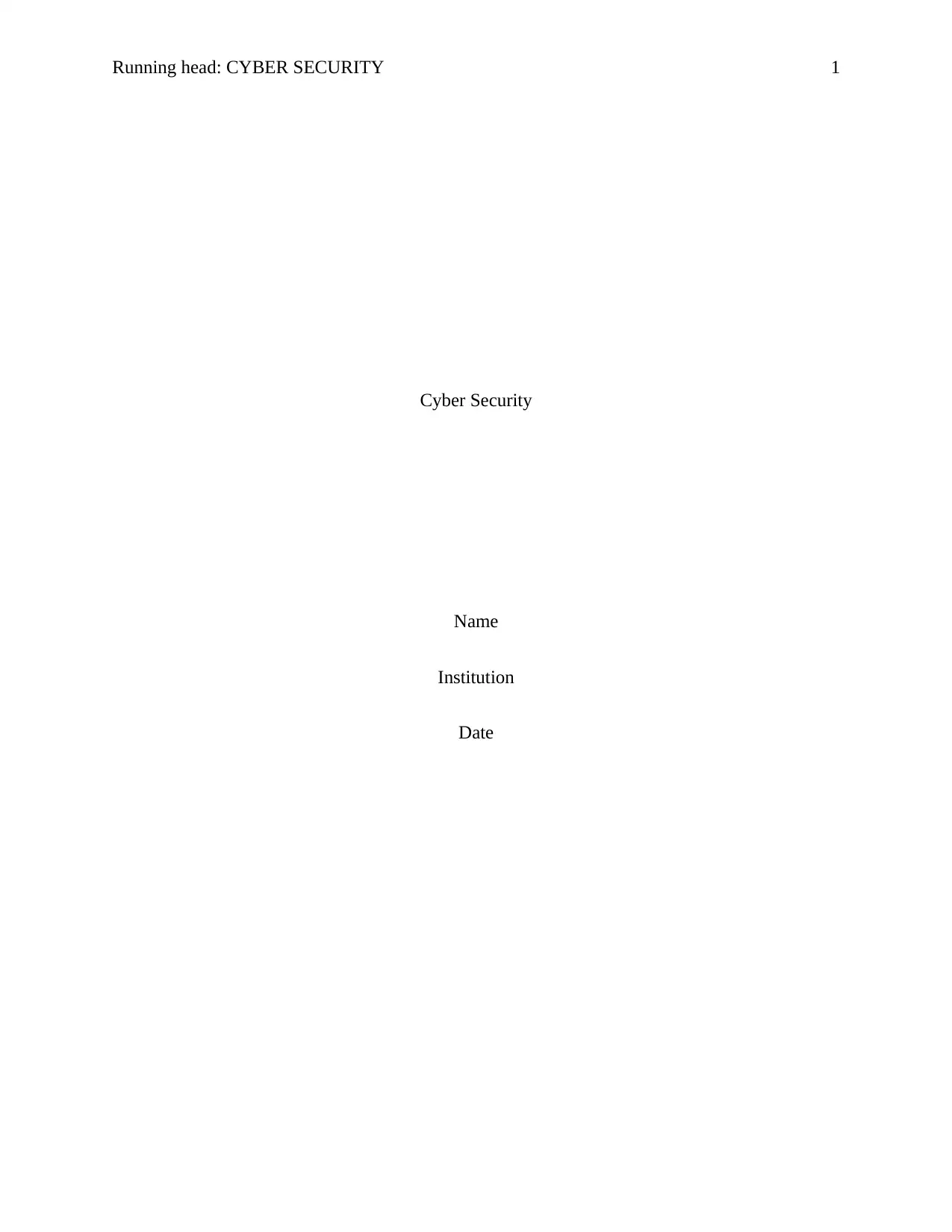
Running head: CYBER SECURITY 1
Cyber Security
Name
Institution
Date
Cyber Security
Name
Institution
Date
Paraphrase This Document
Need a fresh take? Get an instant paraphrase of this document with our AI Paraphraser
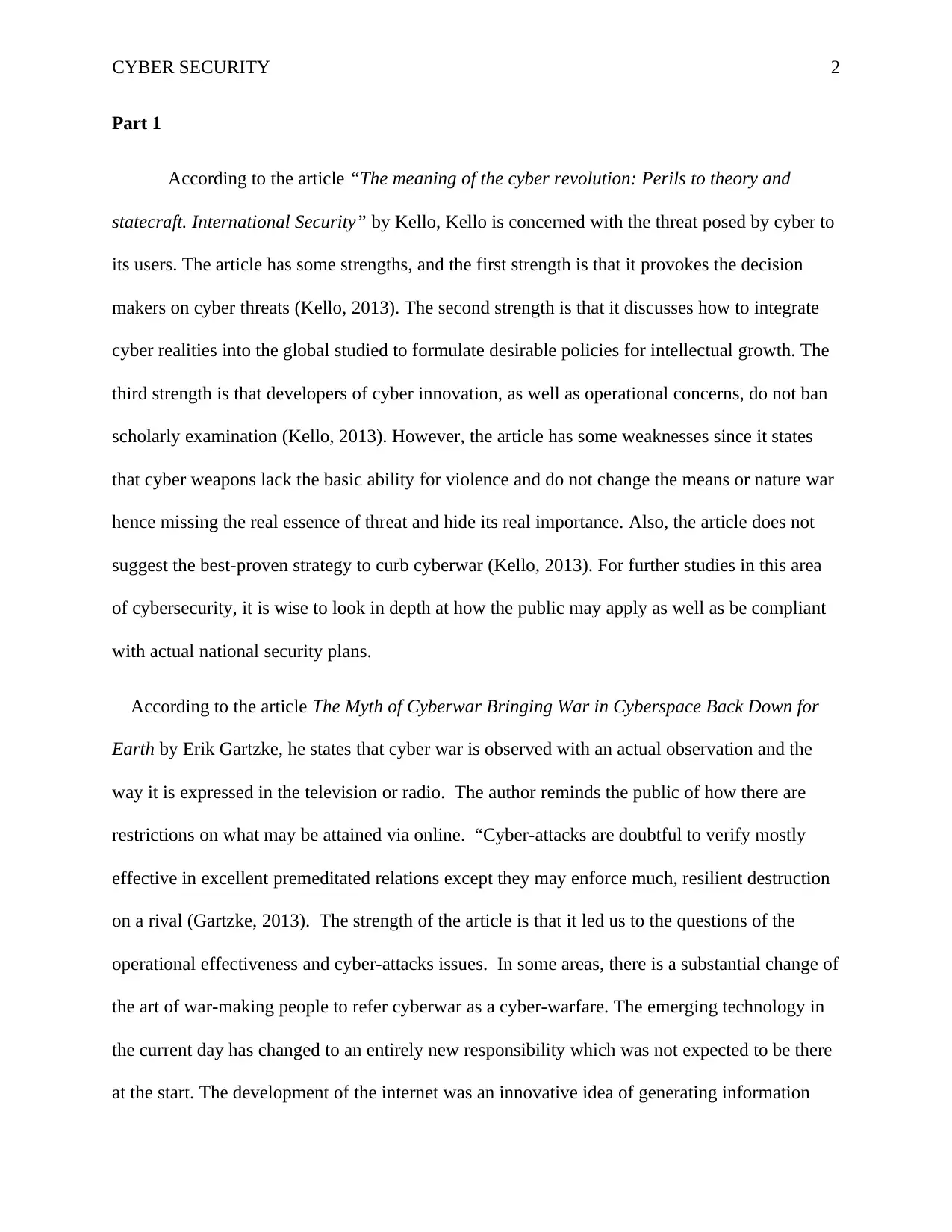
CYBER SECURITY 2
Part 1
According to the article “The meaning of the cyber revolution: Perils to theory and
statecraft. International Security” by Kello, Kello is concerned with the threat posed by cyber to
its users. The article has some strengths, and the first strength is that it provokes the decision
makers on cyber threats (Kello, 2013). The second strength is that it discusses how to integrate
cyber realities into the global studied to formulate desirable policies for intellectual growth. The
third strength is that developers of cyber innovation, as well as operational concerns, do not ban
scholarly examination (Kello, 2013). However, the article has some weaknesses since it states
that cyber weapons lack the basic ability for violence and do not change the means or nature war
hence missing the real essence of threat and hide its real importance. Also, the article does not
suggest the best-proven strategy to curb cyberwar (Kello, 2013). For further studies in this area
of cybersecurity, it is wise to look in depth at how the public may apply as well as be compliant
with actual national security plans.
According to the article The Myth of Cyberwar Bringing War in Cyberspace Back Down for
Earth by Erik Gartzke, he states that cyber war is observed with an actual observation and the
way it is expressed in the television or radio. The author reminds the public of how there are
restrictions on what may be attained via online. “Cyber-attacks are doubtful to verify mostly
effective in excellent premeditated relations except they may enforce much, resilient destruction
on a rival (Gartzke, 2013). The strength of the article is that it led us to the questions of the
operational effectiveness and cyber-attacks issues. In some areas, there is a substantial change of
the art of war-making people to refer cyberwar as a cyber-warfare. The emerging technology in
the current day has changed to an entirely new responsibility which was not expected to be there
at the start. The development of the internet was an innovative idea of generating information
Part 1
According to the article “The meaning of the cyber revolution: Perils to theory and
statecraft. International Security” by Kello, Kello is concerned with the threat posed by cyber to
its users. The article has some strengths, and the first strength is that it provokes the decision
makers on cyber threats (Kello, 2013). The second strength is that it discusses how to integrate
cyber realities into the global studied to formulate desirable policies for intellectual growth. The
third strength is that developers of cyber innovation, as well as operational concerns, do not ban
scholarly examination (Kello, 2013). However, the article has some weaknesses since it states
that cyber weapons lack the basic ability for violence and do not change the means or nature war
hence missing the real essence of threat and hide its real importance. Also, the article does not
suggest the best-proven strategy to curb cyberwar (Kello, 2013). For further studies in this area
of cybersecurity, it is wise to look in depth at how the public may apply as well as be compliant
with actual national security plans.
According to the article The Myth of Cyberwar Bringing War in Cyberspace Back Down for
Earth by Erik Gartzke, he states that cyber war is observed with an actual observation and the
way it is expressed in the television or radio. The author reminds the public of how there are
restrictions on what may be attained via online. “Cyber-attacks are doubtful to verify mostly
effective in excellent premeditated relations except they may enforce much, resilient destruction
on a rival (Gartzke, 2013). The strength of the article is that it led us to the questions of the
operational effectiveness and cyber-attacks issues. In some areas, there is a substantial change of
the art of war-making people to refer cyberwar as a cyber-warfare. The emerging technology in
the current day has changed to an entirely new responsibility which was not expected to be there
at the start. The development of the internet was an innovative idea of generating information
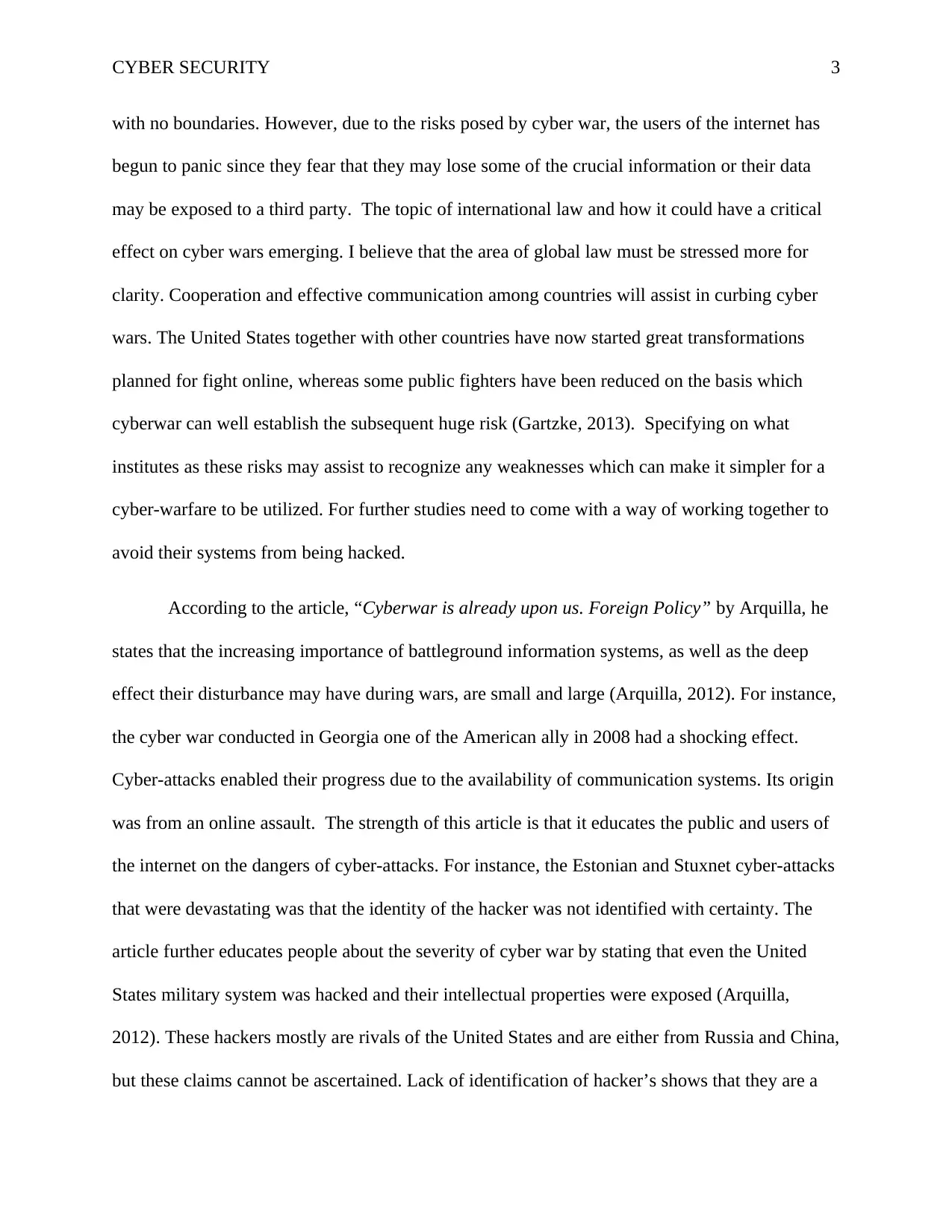
CYBER SECURITY 3
with no boundaries. However, due to the risks posed by cyber war, the users of the internet has
begun to panic since they fear that they may lose some of the crucial information or their data
may be exposed to a third party. The topic of international law and how it could have a critical
effect on cyber wars emerging. I believe that the area of global law must be stressed more for
clarity. Cooperation and effective communication among countries will assist in curbing cyber
wars. The United States together with other countries have now started great transformations
planned for fight online, whereas some public fighters have been reduced on the basis which
cyberwar can well establish the subsequent huge risk (Gartzke, 2013). Specifying on what
institutes as these risks may assist to recognize any weaknesses which can make it simpler for a
cyber-warfare to be utilized. For further studies need to come with a way of working together to
avoid their systems from being hacked.
According to the article, “Cyberwar is already upon us. Foreign Policy” by Arquilla, he
states that the increasing importance of battleground information systems, as well as the deep
effect their disturbance may have during wars, are small and large (Arquilla, 2012). For instance,
the cyber war conducted in Georgia one of the American ally in 2008 had a shocking effect.
Cyber-attacks enabled their progress due to the availability of communication systems. Its origin
was from an online assault. The strength of this article is that it educates the public and users of
the internet on the dangers of cyber-attacks. For instance, the Estonian and Stuxnet cyber-attacks
that were devastating was that the identity of the hacker was not identified with certainty. The
article further educates people about the severity of cyber war by stating that even the United
States military system was hacked and their intellectual properties were exposed (Arquilla,
2012). These hackers mostly are rivals of the United States and are either from Russia and China,
but these claims cannot be ascertained. Lack of identification of hacker’s shows that they are a
with no boundaries. However, due to the risks posed by cyber war, the users of the internet has
begun to panic since they fear that they may lose some of the crucial information or their data
may be exposed to a third party. The topic of international law and how it could have a critical
effect on cyber wars emerging. I believe that the area of global law must be stressed more for
clarity. Cooperation and effective communication among countries will assist in curbing cyber
wars. The United States together with other countries have now started great transformations
planned for fight online, whereas some public fighters have been reduced on the basis which
cyberwar can well establish the subsequent huge risk (Gartzke, 2013). Specifying on what
institutes as these risks may assist to recognize any weaknesses which can make it simpler for a
cyber-warfare to be utilized. For further studies need to come with a way of working together to
avoid their systems from being hacked.
According to the article, “Cyberwar is already upon us. Foreign Policy” by Arquilla, he
states that the increasing importance of battleground information systems, as well as the deep
effect their disturbance may have during wars, are small and large (Arquilla, 2012). For instance,
the cyber war conducted in Georgia one of the American ally in 2008 had a shocking effect.
Cyber-attacks enabled their progress due to the availability of communication systems. Its origin
was from an online assault. The strength of this article is that it educates the public and users of
the internet on the dangers of cyber-attacks. For instance, the Estonian and Stuxnet cyber-attacks
that were devastating was that the identity of the hacker was not identified with certainty. The
article further educates people about the severity of cyber war by stating that even the United
States military system was hacked and their intellectual properties were exposed (Arquilla,
2012). These hackers mostly are rivals of the United States and are either from Russia and China,
but these claims cannot be ascertained. Lack of identification of hacker’s shows that they are a
⊘ This is a preview!⊘
Do you want full access?
Subscribe today to unlock all pages.

Trusted by 1+ million students worldwide
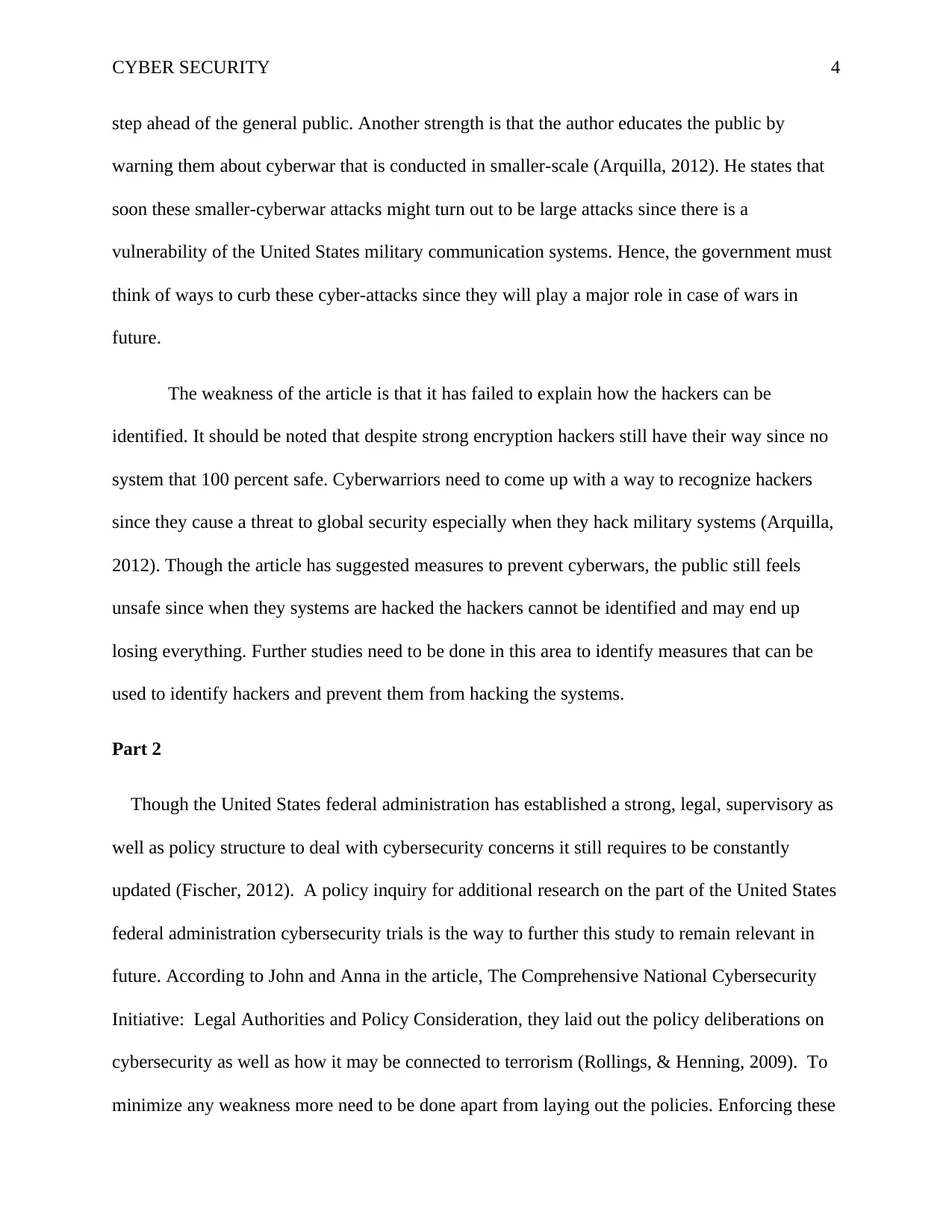
CYBER SECURITY 4
step ahead of the general public. Another strength is that the author educates the public by
warning them about cyberwar that is conducted in smaller-scale (Arquilla, 2012). He states that
soon these smaller-cyberwar attacks might turn out to be large attacks since there is a
vulnerability of the United States military communication systems. Hence, the government must
think of ways to curb these cyber-attacks since they will play a major role in case of wars in
future.
The weakness of the article is that it has failed to explain how the hackers can be
identified. It should be noted that despite strong encryption hackers still have their way since no
system that 100 percent safe. Cyberwarriors need to come up with a way to recognize hackers
since they cause a threat to global security especially when they hack military systems (Arquilla,
2012). Though the article has suggested measures to prevent cyberwars, the public still feels
unsafe since when they systems are hacked the hackers cannot be identified and may end up
losing everything. Further studies need to be done in this area to identify measures that can be
used to identify hackers and prevent them from hacking the systems.
Part 2
Though the United States federal administration has established a strong, legal, supervisory as
well as policy structure to deal with cybersecurity concerns it still requires to be constantly
updated (Fischer, 2012). A policy inquiry for additional research on the part of the United States
federal administration cybersecurity trials is the way to further this study to remain relevant in
future. According to John and Anna in the article, The Comprehensive National Cybersecurity
Initiative: Legal Authorities and Policy Consideration, they laid out the policy deliberations on
cybersecurity as well as how it may be connected to terrorism (Rollings, & Henning, 2009). To
minimize any weakness more need to be done apart from laying out the policies. Enforcing these
step ahead of the general public. Another strength is that the author educates the public by
warning them about cyberwar that is conducted in smaller-scale (Arquilla, 2012). He states that
soon these smaller-cyberwar attacks might turn out to be large attacks since there is a
vulnerability of the United States military communication systems. Hence, the government must
think of ways to curb these cyber-attacks since they will play a major role in case of wars in
future.
The weakness of the article is that it has failed to explain how the hackers can be
identified. It should be noted that despite strong encryption hackers still have their way since no
system that 100 percent safe. Cyberwarriors need to come up with a way to recognize hackers
since they cause a threat to global security especially when they hack military systems (Arquilla,
2012). Though the article has suggested measures to prevent cyberwars, the public still feels
unsafe since when they systems are hacked the hackers cannot be identified and may end up
losing everything. Further studies need to be done in this area to identify measures that can be
used to identify hackers and prevent them from hacking the systems.
Part 2
Though the United States federal administration has established a strong, legal, supervisory as
well as policy structure to deal with cybersecurity concerns it still requires to be constantly
updated (Fischer, 2012). A policy inquiry for additional research on the part of the United States
federal administration cybersecurity trials is the way to further this study to remain relevant in
future. According to John and Anna in the article, The Comprehensive National Cybersecurity
Initiative: Legal Authorities and Policy Consideration, they laid out the policy deliberations on
cybersecurity as well as how it may be connected to terrorism (Rollings, & Henning, 2009). To
minimize any weakness more need to be done apart from laying out the policies. Enforcing these
Paraphrase This Document
Need a fresh take? Get an instant paraphrase of this document with our AI Paraphraser
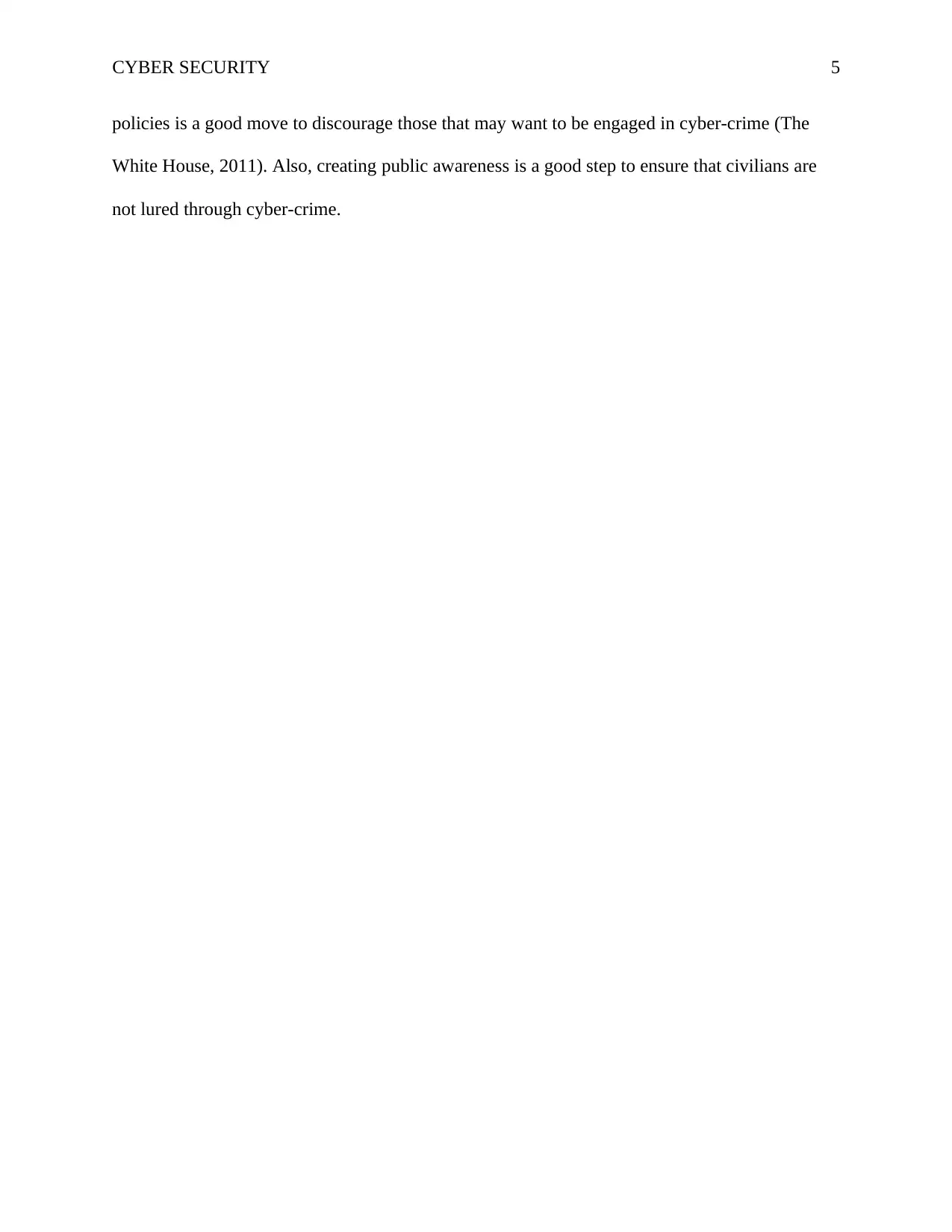
CYBER SECURITY 5
policies is a good move to discourage those that may want to be engaged in cyber-crime (The
White House, 2011). Also, creating public awareness is a good step to ensure that civilians are
not lured through cyber-crime.
policies is a good move to discourage those that may want to be engaged in cyber-crime (The
White House, 2011). Also, creating public awareness is a good step to ensure that civilians are
not lured through cyber-crime.
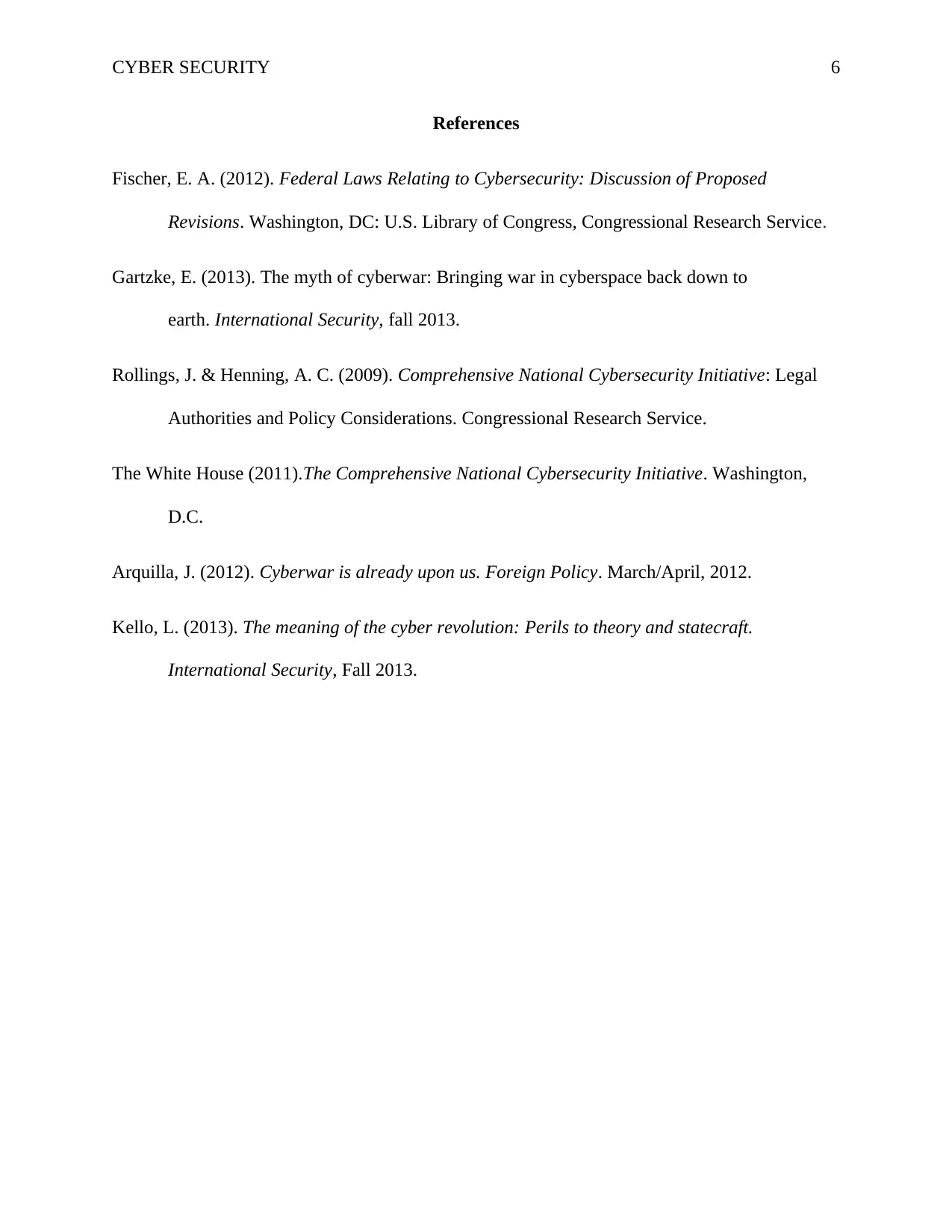
CYBER SECURITY 6
References
Fischer, E. A. (2012). Federal Laws Relating to Cybersecurity: Discussion of Proposed
Revisions. Washington, DC: U.S. Library of Congress, Congressional Research Service.
Gartzke, E. (2013). The myth of cyberwar: Bringing war in cyberspace back down to
earth. International Security, fall 2013.
Rollings, J. & Henning, A. C. (2009). Comprehensive National Cybersecurity Initiative: Legal
Authorities and Policy Considerations. Congressional Research Service.
The White House (2011).The Comprehensive National Cybersecurity Initiative. Washington,
D.C.
Arquilla, J. (2012). Cyberwar is already upon us. Foreign Policy. March/April, 2012.
Kello, L. (2013). The meaning of the cyber revolution: Perils to theory and statecraft.
International Security, Fall 2013.
References
Fischer, E. A. (2012). Federal Laws Relating to Cybersecurity: Discussion of Proposed
Revisions. Washington, DC: U.S. Library of Congress, Congressional Research Service.
Gartzke, E. (2013). The myth of cyberwar: Bringing war in cyberspace back down to
earth. International Security, fall 2013.
Rollings, J. & Henning, A. C. (2009). Comprehensive National Cybersecurity Initiative: Legal
Authorities and Policy Considerations. Congressional Research Service.
The White House (2011).The Comprehensive National Cybersecurity Initiative. Washington,
D.C.
Arquilla, J. (2012). Cyberwar is already upon us. Foreign Policy. March/April, 2012.
Kello, L. (2013). The meaning of the cyber revolution: Perils to theory and statecraft.
International Security, Fall 2013.
⊘ This is a preview!⊘
Do you want full access?
Subscribe today to unlock all pages.

Trusted by 1+ million students worldwide
1 out of 6
Related Documents
Your All-in-One AI-Powered Toolkit for Academic Success.
+13062052269
info@desklib.com
Available 24*7 on WhatsApp / Email
![[object Object]](/_next/static/media/star-bottom.7253800d.svg)
Unlock your academic potential
Copyright © 2020–2025 A2Z Services. All Rights Reserved. Developed and managed by ZUCOL.




